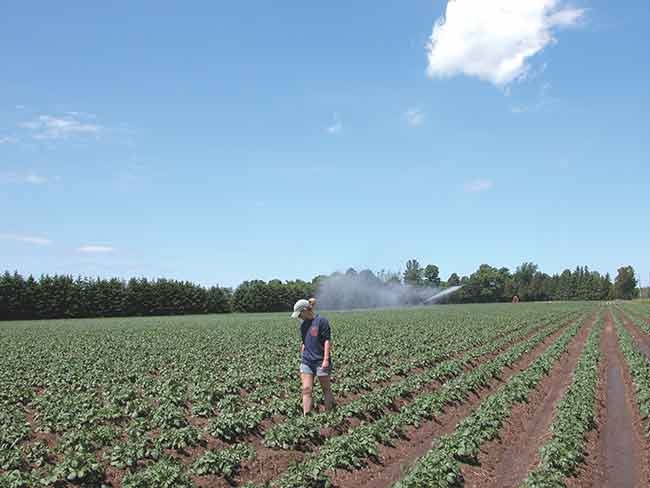
Features
Agronomy
Crop Protection
Scouts on it
Potatoes are a high input, high value crop and ensuring their success should not be left to chance. Certain variables, like the weather, cannot be predicted or controlled, but monitoring the weather can certainly help assess if problems affected by weather can occur. But suspecting there could be a problem is not the same as knowing for certain the crop needs more attention than just a drive-by glance provides.
Growers with numerous acres sown to different crops or with fields scattered across many miles may not have the time to monitor each and every facet of their farming operation. Sometimes it pays to hire experts. Many growers understand the value of hiring field scouts to monitor the activity in their fields, to alert them to possible problems and to advise them on solutions.
According to Eugenia Banks, an Ontario potato specialist, “field scouting is the backbone of a potato integrated pest management program.” In 2015, Banks offered classes on field scouting through the Ontario Ministry of Agriculture, Food and Rural Affairs to assist scouts in understanding more about the issues facing potato crops.
“The information collected by scouts is reported to growers who can make important pest control decisions based on their findings,” Banks explains. “A scout can provide timely information on the status of the crop, the level of insect populations and their distribution in the field, incidence of diseases and other problems caused by weather conditions, and potential issues with weed infestation. This information helps growers to time the application of crop protection products, and scouts are able to monitor the efficacy of the pesticide chosen. In addition, field scouting allows growers to do spot treatments for pests, which are possible when pests are concentrated only in specific areas of fields. Spot treatments help growers enhance farm sustainability and environmental protection.”
Professional scouts make timely visits to a field to assess aspects of crop development and watch for disease, insects and weeds that could impede that development. By hiring a scout, growers can focus attention on other aspects of the operation, such as preparing storage to accept the crop or ensuring harvest equipment is ready to go to work. For a scout, the main focus is the crop and having a scout regularly walking the field is worth the fee. Most scouts contract to walk a field once a week, but many will visit more frequently depending on potential pest pressures or changes in the weather that could affect pest or disease development.
“Scouts can help prevent diseases because we are in the field at least once a week,” says Karen VanderZaag. She became a scout five years ago when her father hired her to scout his fields near Alliston, Ont., as a summer job. After discovering she liked the work, she takes Banks’ field scouting update courses annually.
“It’s important for a scout to refresh their knowledge every year and to learn what might be something new to watch for,” she explains.
“It can take an hour with multiple scouts to scout a field, but as much as two or three hours if the field is large or the risk of disease is high. You want to see the disease before it becomes a major problem across the field.”
VanderZaag takes a close eye to the field, looking for pests, diseases, and anything else that may affect the crop. “My main concern is late blight, but I scout for everything from weed pressure at the beginning of the season to insects throughout the season. In 2015, Colorado potato beetle was identified as a problem early in the season and I considered insect pressure and thresholds before making a recommendation.”
Scouts offer “a close extra look or inspection while walking through the field,” according to VanderZaag. In her observation, not all growers hire scouts, but the benefits are hard to deny. An example of the value a scout can bring to an operation is the need to regularly watch for late blight. “If you don’t have someone scouting your field and you aren’t doing it regularly yourself and you have late blight, it can cross the entire field and will be in the neighbour’s field by the time you notice,” VanderZaag cautions.
Scouts can be hired on an hourly basis or through a crop protection dealer, who may offer scouting services as part of a package that includes custom spraying. For VanderZaag, scouting is her summer job while she completes her education in agriculture. But there are also businesses that offer scouting services. On average, expect to pay close to $6,000 annually for a scout. The value can vary, depending on whether you are hiring hourly or on a contract and how much you expect your scout to do.
Staying current is also part of a good scout’s resumé, which is why many take the courses offered by Banks or other experts. Most growers are too busy to maintain their knowledge of pests and disease identification, and with new pests arriving regularly, getting to know new ones is time consuming. A scout’s job is to know what is new or which old pests may be a problem in any given year.
Averting such disasters as crop failure due to late blight, or losses due to a beetle infestation, will likely make up for the cost of the scout. Hiring a scout isn’t just about identifying pests and getting advice on spraying – it also buys peace of mind. Knowing your crop is in good hands is worth the cost.
March 9, 2016 By Rosalie I. Tennison
 Field scouting is an important part of managing your potato crop. Potatoes are a high input
Field scouting is an important part of managing your potato crop. Potatoes are a high inputPrint this page